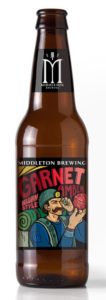Top 10 Belgian Pale Ales brewed in North America
This Top Ten Belgian Pale Ales list is from the U.S. Open Beer Championship, Great American Beer Festival, and World Beer Cup.The top 10 Belgian Pale Ales are characterized by low, but noticeable, hop bitterness, flavor, and aroma Light to medium body and low malt aroma are typical. They are light gold to deep amber in color. Noble-type hops are commonly used. Low to medium fruity esters are evident in aroma and flavor. Low levels of phenolic spiciness from yeast byproducts may be perceived. Low caramel or toasted malt flavor is okay. Diacetyl should not be perceived. Chill haze is allowable at cold temperatures. ABV: 4.10% – 6.30%. IBU: 20-30.

1. Garnet – Middleton Brewing – Texas
2. Breton Blonde – Metazoa Brewing – Indiana
3. Rare Vos – Brewery Ommegang – New York
4. Redemption – Russian River Brewing – California
5. G.P.A – Gino’s Brewing – Illinois
6. Mons Blonde D’Abbaye – Belgh Brasse – Canada
7. Trappist Ale – The Spencer Brewery – Massachusetts
8. Fleur De Houblon – Brewery Ommegang – New York
9. Allagash House Beer – Allagash Brewing – Maine
10. A Little Crazy – Revolution Brewing – Illinois
History of Beligan Pale Ales
Belgian Pale Ale, a style with roots in the early 20th century, emerged as a response to the growing popularity of British pale ales and German lagers in Europe. Brewed primarily in the Flanders region, particularly around Antwerp, these ales were developed to compete with the crisp, refreshing qualities of lagers while retaining a distinctly Belgian character. The style was pioneered by breweries like De Koninck, whose flagship beer, often referred to simply as “Bolleke” in its signature glass, became a hallmark of the style. Belgian Pale Ales are characterized by their balanced malt and hop profiles, moderate alcohol content (typically 4.8–5.5% ABV), and a focus on drinkability, with subtle fruitiness and spice from Belgian yeast strains. Unlike the stronger, more complex Trappist or Abbey ales, these beers were designed for everyday enjoyment, often served in local taverns as a sessionable option for workers and locals.
The evolution of Belgian Pale Ale reflects Belgium’s broader brewing tradition, which emphasizes regional diversity and innovation within constraints. During the mid-20th century, as industrial lagers gained dominance, many small Belgian breweries struggled, but the Pale Ale style persisted due to its accessibility and versatility. By the late 20th and early 21st centuries, the global craft beer movement sparked renewed interest in the style, with brewers both in Belgium and abroad experimenting with its approachable framework. Modern examples, like those from Brouwerij Palm or Omer Vander Ghinste, maintain the traditional golden-to-amber hue, bready malt backbone, and mild hop bitterness, while some incorporate contemporary twists like dry-hopping or mixed fermentation. Despite its understated profile compared to bolder Belgian styles like Saisons or Tripels, Belgian Pale Ale remains a cultural touchstone, embodying the balance of tradition and adaptability in Belgium’s storied brewing heritage.
Top 10 Beers in America – Ales Lagers Specialty Barrel Aged